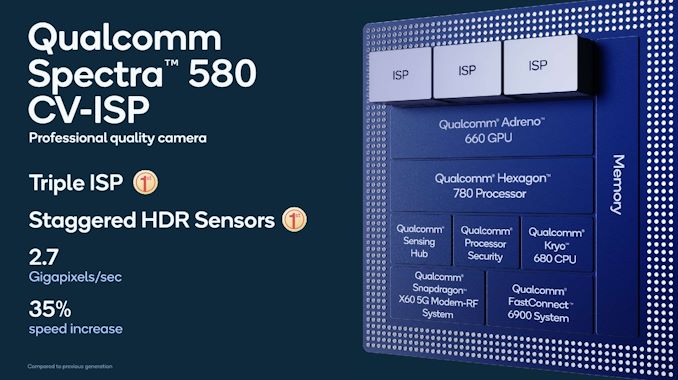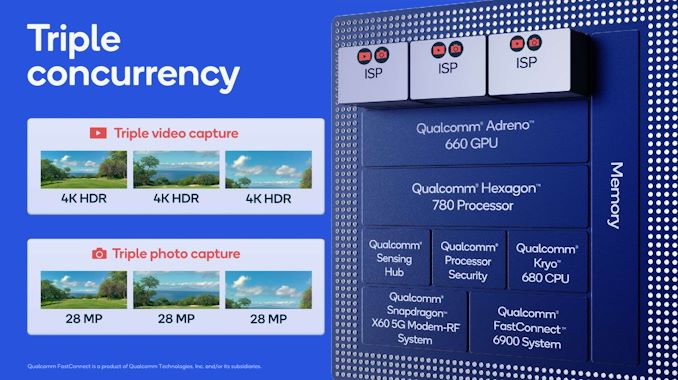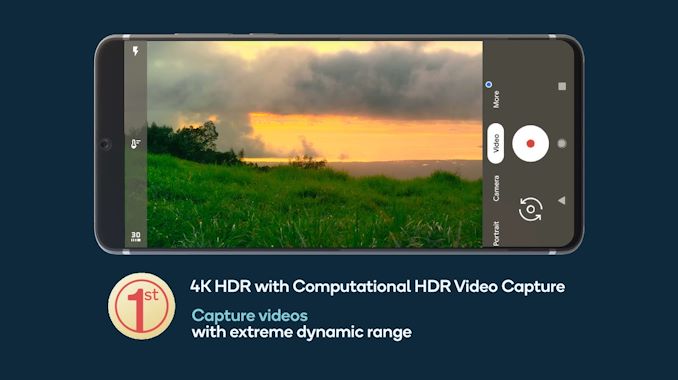Qualcomm Details The Snapdragon 888: 3rd Gen 5G & Cortex-X1 on 5nm
by Andrei Frumusanu on December 2, 2020 10:00 AM EST- Posted in
- Mobile
- Qualcomm
- Smartphones
- SoCs
- 5G
- Cortex A78
- Cortex X1
- Snapdragon 888
Triple ISPs: Concurrent Triple-Camera Usage
Interestingly enough, during yesterday’s keynote event, Qualcomm described themselves as a camera company, which is a funny way to see things, but actually somewhat makes sense given the large leaps in smartphone camera capture capabilities over the recent years.
The new Snapdragon 888 pushes the envelope in terms camera abilities by adding a whole new independent third ISP to the SoC, allowing the SoC to now run three independent camera modules concurrently, opening up new use cases for vendors and camera applications.
The new triple-ISP architecture now increases the overall pixel processing throughput by 35% to 2.7Gigapixels/s, allowing for concurrent usage of up to three 28MP sensors with zero shutter lag captures. Alternatively, you can use a combination of 64+25MP sensors with ZSL, or a single 84MP sensor with ZSL. There’s still also support for ultra-high-resolution sensors up to 200MP, but image captures here don’t support ZSL.
Allowing concurrent captures of three sensors now allows for the holy trifecta of ultra-wide-angle, wide-angle and telephoto modules to capture a scene at the same time, allowing for more interesting use-cases such as image stitching and image fusion to happen to seamlessly.
One interesting capability that Qualcomm was advertising is triple-stream 4K HDR video recording. That’s a bit of an odd-ball use-case as I do wonder about the practical benefits, but I do at least hope that the new triple ISP system allows for more seamless switching and zooming in and out between the various camera modules during video recording.
Video recording capabilities this year don’t seem to have changed, compared to the Snapdragon 865. This means 4K120 or 8K30 are still the peak capture modes, supporting also slow-motion of 720p960. Formats are also unchanged, with HEVC encoding in HDR formats such as HDR10+ or Dolby Vision being supported.
AV1 decoding didn’t make the cut this year unfortunately, which means wide-spread adoption in mobile for the codec will be delayed for another year.
While the video encoding formats haven’t changed, the image processing capabilities for HDR capture has. Thanks to the new ISPs and the raw performance throughput, the new Snapdragon 888 will be able to capture 4K HDR footage with the more advanced computational HDR processing being applied on each and every frame of the video.
Qualcomm claims that the new ISP in the Snapdragon 888 is the first to support new next-generation staggered HDR sensors.

Source: OmniVision
These are sensors that can have multiple rolling shutters, meaning sensor line readouts, active at the same time on the sensor. Instead of taking multiple exposures one at a time sequentially by scanning out the sensor matrix from start to finish, the sensor will start another exposure immediately after the completed line read-out, reducing the time in-between exposures greatly. This should allow for significant less motion ghosting between the exposures and a sharper resulting recombined HDR image capture than current generation sensors which only have a single active line readout on the sensor.
While we haven’t actually heard of such sensors from Samsung or Sony yet, Qualcomm is adamant that we’ll be seeing smartphones in 2021 employing this new technology.
A further improvement for still-picture captures is the advancement of the new multi-frame noise reduction engines inside of the ISPs. It’s said that the quality of the noise reduction has been improved this generation, allowing for even better low-light captures with the native capture mode (no computational photography).















123 Comments
View All Comments
Device Guru - Monday, February 1, 2021 - link
As I understand it, Band 53/n53 will make its first appearance in the 888. A great band for aggregation/5G plus it is a global band providing users with maximum flexibility.ChrisGX - Thursday, February 4, 2021 - link
While on its face going with unaltered clock rates for the SD888 compared to the previous (SD865) generation seems like the smart move because it gives a good peak performance boost of around 30% (when using the new Samsung 5LPE process) without pushing power consumption into problematic territory - reduced power consumption on the modestly clocked A78 cores should more than compensate for any increase in power consumption on the X1 core - the overall picture of power consumption for the SD888 doesn't seem to have quite worked out. Early information on the performance of the SD888 SoC in real world situations seems to indicate that while is does a great job of sustaining close to peak performance levels even when under heavy load it doesn't achieve that feat without producing troublingly elevated thermals. Many reports of engineering samples of new flagship Android smartphones becoming uncomfortably hot and suffering accelerated battery drain have recently appeared.What are we to make of this? First, it is clear that Qualcomm has tried to achieve a lot in this generation - almost everything in the SD888 has changed and the most impressive improvements are outside the CPU complex. Most notably the 5G modem is now integrated with the Snapdragon SoC and the iGPU has undergone a major upgrade. It seems that the power savings available from the 5LPE process have been insufficient to deliver the full benefit of incorporating these improved components. Qualcomm, no doubt, understood that a feature rich Snapdragon SoC was going to be essential to reassure the Android faithful that flagship Android phones were keeping pace with the iPhone. The reassurance in this case is partial. A truly compelling case for the SD888 might require an upgraded 5nm silicon process that matches the density and power savings of TSMC's N5 process. The SD888 looks to me like the right SoC in the wrong (Samsung 5LPE) silicon. Where is the 5LPP process that the SD888 (and the Exynos 2100) needs Samsung?
Indian Tech Hunter - Saturday, September 4, 2021 - link
Really want to own a Smartphone having Snapdragon 888 or even Snapdragon 888+. It is a 5nm based architecture chipset means it will be lot powerful and efficient too thats why I want smartphone having this chipset.